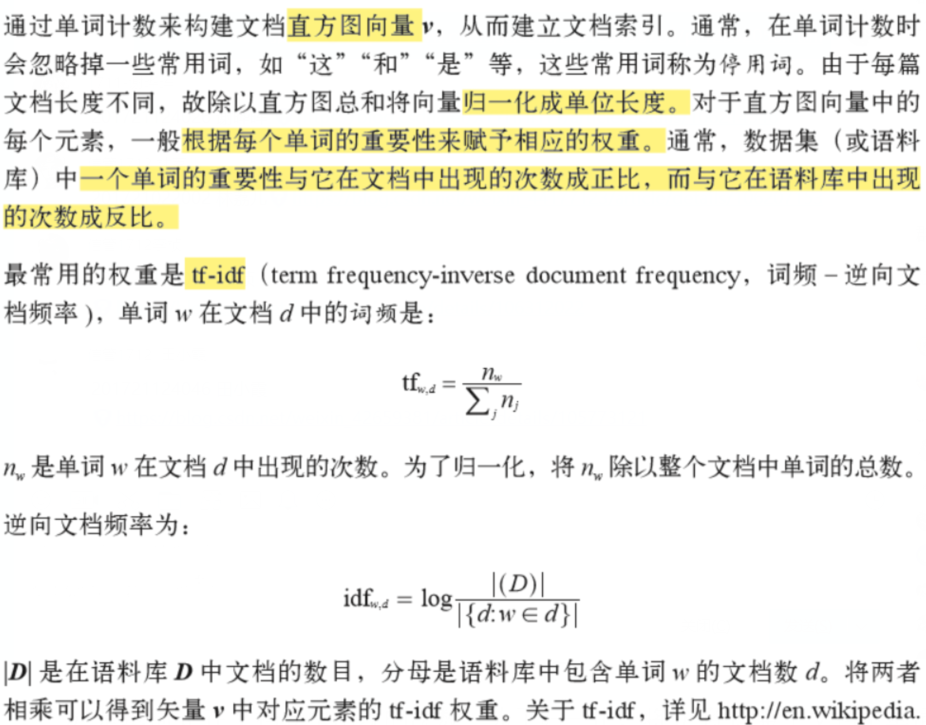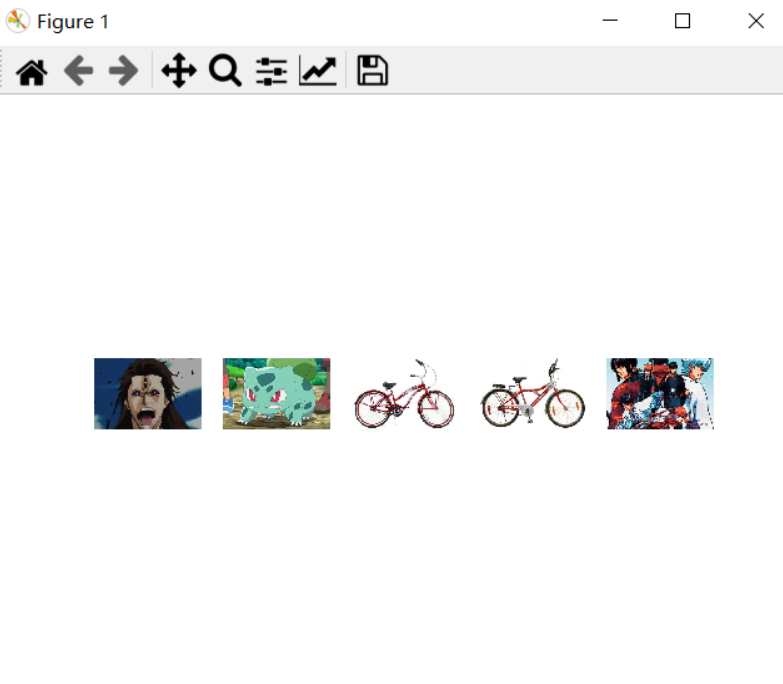计算视觉——图像检索
-
一、简述
一、Bag of features
1.1
Bag of features概述BOF方法源自于文本处理的词袋模型。Bag-of-words model (BoW model) 最早出现在NLP和IR领域. 该模型忽略掉文本的语法和语序, 用一组无序的单词(words)来表达一段文字或一个文档. 近年来, BoW模型被广泛应用于计算机视觉中. 与应用于文本的BoW类比, 图像的特征(feature)被当作单词(Word)。视觉上具相似性的图像。这样返回的图像可以是颜色相似、纹理相似、图像中的物体或场景相似;总之,基本上可以是这些图像自身共有的任何信息。
1.2 Bag of features基本检索流程
Bag of features步骤
1.提取图像特征;
2.对特征进行聚类,得到可视化字典(visual vocabulary);
3.根据字典将图片表示成向量,即直方图;
4.使用得到的直方图表示的特征进行分类器的训练。
特征提取
首先我们从原始图像中提取特征,如图4所示。常用的特征提取方法有SIFT,SURF。SIFT得到的特征描述是128维度的向量,相比SISF,SURF计算量更小些,得到的特征是64维的向量。也有使用HoG和LBP来进行特征提取的。注意特征提取的方法要满足旋转不变性以及尺寸不变性。
字典生成
对所有的图片提取完特征后,将所有的特征进行聚类,比如使用K-Means聚类,得到K类,每个类别看作一个word,这样我们就得到了字典,
直方图表示
上一步训练得到的字典,是为了这一步对图像特征进行量化。对于一幅图像而言,我们可以提取出大量的特征,但这些特征(如SIFT提取的特征)仍然属于一种浅层的表示,缺乏代表性。因此,这一步的目标,是根据字典重新提取图像的高层特征。具体做法是,对于每一张图片得到的每一个特征(如SIFT提取的特征),都可以在字典中找到一个最相似的word(实际上就是将特征输入到得到的聚类模型,得到类别),统计相似的每种word的数量,于是就得到一个K维的直方图。
训练分类器
对于每张图片,我们得到了其对应的直方图向量,当然也知道其对应的属于哪种物品的标记。这样我们就可以构造训练集来训练某种分类器。当需要进行预测时,我们先测试集的图片中提取特征,然后利用字典量化得到直方图,输入训练好的分类器,得到预测的类别。
Bag of Feature 的缺点
Bag of Feature 完全没有考虑到特征之间的位置关系,而位置信息对于人理解图片来说,作用是很明显的。
1.3TF—IDF

-
二、SIFT特征提取
由于图像中的词汇不像文本文档那样是现成的单词,所以我们首先要从图像中提取出相互独立的视觉词汇。然后为创建视觉单词词汇,第一步要做的就是提取特征描述子。
SIFT算法是提取图像中局部不变特征的应用最广的算法,所以我们可以采用SIFT算法才进行特征提取。
将每幅图像提取出的描述子保存在一个文件中,构建视觉词典。
# -*- coding: utf-8 -*- import pickle from PCV.imagesearch import vocabulary from PCV.tools.imtools import get_imlist import sift # 获取图像列表 imlist = get_imlist('D:/Python/ComputerView/test1/first1000/') nbr_images = len(imlist) # 获取特征列表 featlist = [imlist[i][:-3] + 'sift' for i in range(nbr_images)] # 提取文件夹下图像的sift特征 for i in range(nbr_images): sift.process_image(imlist[i], featlist[i]) # 生成词汇 voc = vocabulary.Vocabulary('ukbenchtest') voc.train(featlist, 100, 10) # 保存词汇 # saving vocabulary with open('D:/Python/ComputerView/test1/first1000/vocabulary.pkl', 'wb') as f: pickle.dump(voc, f) print('vocabulary is:', voc.name, voc.nbr_words)

-
三、视觉词典(visual vocabulary)
# -*- coding: utf-8 -*- import pickle from PCV.imagesearch import vocabulary from PCV.tools.imtools import get_imlist from PCV.localdescriptors import sift #获取图像列表 imlist = get_imlist('first1000/') nbr_images = len(imlist) #获取特征列表 featlist = [imlist[i][:-3]+'sift' for i in range(nbr_images)] #提取文件夹下图像的sift特征 for i in range(nbr_images): sift.process_image(imlist[i], featlist[i]) #生成词汇 voc = vocabulary.Vocabulary('ukbenchtest') voc.train(featlist, 1000, 10) #保存词汇 # saving vocabulary with open('first1000/vocabulary.pkl', 'wb') as f: pickle.dump(voc, f) print 'vocabulary is:', voc.name, voc.nbr_words
-
四、匹配
# -*- coding: utf-8 -*- import pickle from PCV.localdescriptors import sift from PCV.imagesearch import imagesearch from PCV.geometry import homography from PCV.tools.imtools import get_imlist # load image list and vocabulary #载入图像列表 imlist = get_imlist('D:/Study/untitled1/shiyan/') nbr_images = len(imlist) #载入特征列表 featlist = [imlist[i][:-3]+'sift' for i in range(nbr_images)] #载入词汇 with open(r'D:/Study/untitled1/shiyan/vocabulary.pkl', 'rb') as f: voc = pickle.load(f) src = imagesearch.Searcher('testImaAdd3.db',voc) # index of query image and number of results to return #查询图像索引和查询返回的图像数 q_ind = 6 nbr_results = 5 # regular query # 常规查询(按欧式距离对结果排序) res_reg = [w[1] for w in src.query(imlist[q_ind])[:nbr_results]] print ('top matches (regular):', res_reg) # load image features for query image #载入查询图像特征 q_locs,q_descr = sift.read_features_from_file(featlist[q_ind]) fp = homography.make_homog(q_locs[:,:2].T) # RANSAC model for homography fitting #用单应性进行拟合建立RANSAC模型 model = homography.RansacModel() rank = {} # load image features for result #载入候选图像的特征 for ndx in res_reg[1:]: locs,descr = sift.read_features_from_file(featlist[ndx]) # because 'ndx' is a rowid of the DB that starts at 1 # get matches matches = sift.match(q_descr,descr) ind = matches.nonzero()[0] ind2 = matches[ind] tp = homography.make_homog(locs[:,:2].T) # compute homography, count inliers. if not enough matches return empty list try: H,inliers = homography.H_from_ransac(fp[:,ind],tp[:,ind2],model,match_theshold=4) except: inliers = [] # store inlier count rank[ndx] = len(inliers) # sort dictionary to get the most inliers first sorted_rank = sorted(rank.items(), key=lambda t: t[1], reverse=True) res_geom = [res_reg[0]]+[s[0] for s in sorted_rank] print ('top matches (homography):', res_geom) # 显示查询结果 imagesearch.plot_results(src,res_reg[:8]) #常规查询 imagesearch.plot_results(src,res_geom[:8]) #重排后的结果
-
五、TF-IDF解算
#train()函数 def train(self,featurefiles,k=100,subsampling=10): """ Train a vocabulary from features in files listed in featurefiles using k-means with k number of words. Subsampling of training data can be used for speedup. """ nbr_images = len(featurefiles) # read the features from file descr = [] descr.append(sift.read_features_from_file(featurefiles[0])[1]) descriptors = descr[0] #stack all features for k-means for i in arange(1,nbr_images): descr.append(sift.read_features_from_file(featurefiles[i])[1]) descriptors = vstack((descriptors,descr[i])) # k-means: last number determines number of runs self.voc,distortion = kmeans(descriptors[::subsampling,:],k,1)#K-means算法 self.nbr_words = self.voc.shape[0] # go through all training images and project on vocabulary imwords = zeros((nbr_images,self.nbr_words)) for i in range( nbr_images ): imwords[i] = self.project(descr[i]) nbr_occurences = sum( (imwords > 0)*1 ,axis=0) self.idf = log( (1.0*nbr_images) / (1.0*nbr_occurences+1) ) self.trainingdata = featurefiles
-
六、检索
-
# -*- coding: utf-8 -*- import pickle from PCV.imagesearch import imagesearch from PCV.localdescriptors import sift from sqlite3 import dbapi2 as sqlite from PCV.tools.imtools import get_imlist #获取图像列表 imlist = get_imlist('first1000/') nbr_images = len(imlist) #获取特征列表 featlist = [imlist[i][:-3]+'sift' for i in range(nbr_images)] # load vocabulary #载入词汇 with open('first1000/vocabulary.pkl', 'rb') as f: voc = pickle.load(f) #创建索引 indx = imagesearch.Indexer('testImaAdd.db',voc) indx.create_tables() # go through all images, project features on vocabulary and insert #遍历所有的图像,并将它们的特征投影到词汇上 for i in range(nbr_images)[:1000]: locs,descr = sift.read_features_from_file(featlist[i]) indx.add_to_index(imlist[i],descr) # commit to database #提交到数据库 indx.db_commit() con = sqlite.connect('testImaAdd.db') print con.execute('select count (filename) from imlist').fetchone() print con.execute('select * from imlist').fetchone()
![]()
-
常规查询结果

-
重排后查询结果

-
七、总结
1.不选去有文字的图片尽心检索应该会使结果更好一些。数据集中也最好不要出现文字图片,数据集是表情包,所以难免会有文字在其中。
BOF算法还有一个明显的不足,就是它完全没有考虑到特征之间的位置关系,而位置信息对于人理解图片来说,作用是很明显的。 而且在提取特征时不需要相关的 label 进行学习,因此是一种弱监督的学习方法。
2.影响测试正确率的因素如下:
字典大小的选择是问题,字典过大,单词缺乏一般性,对噪声敏感,计算量大,关键是图象投影后的维数高;字典太小,单词区分性能差,对相似的目标特征无法表示。
使用k-means聚类,除了其K和初始聚类中心选择的问题外,对于海量数据,输入矩阵的巨大将使得内存溢出及效率低下。有方法是在海量图片中抽取部分训练集分类,使用朴素贝叶斯分类的方法对图库中其余图片进行自动分类。另外,由于图片爬虫在不断更新后台图像集,重新聚类的代价显而易见。
相似性测度函数用来将图象特征分类到单词本的对应单词上,其涉及线型核,塌方距离测度核,直方图交叉核等的选择。





 浙公网安备 33010602011771号
浙公网安备 33010602011771号